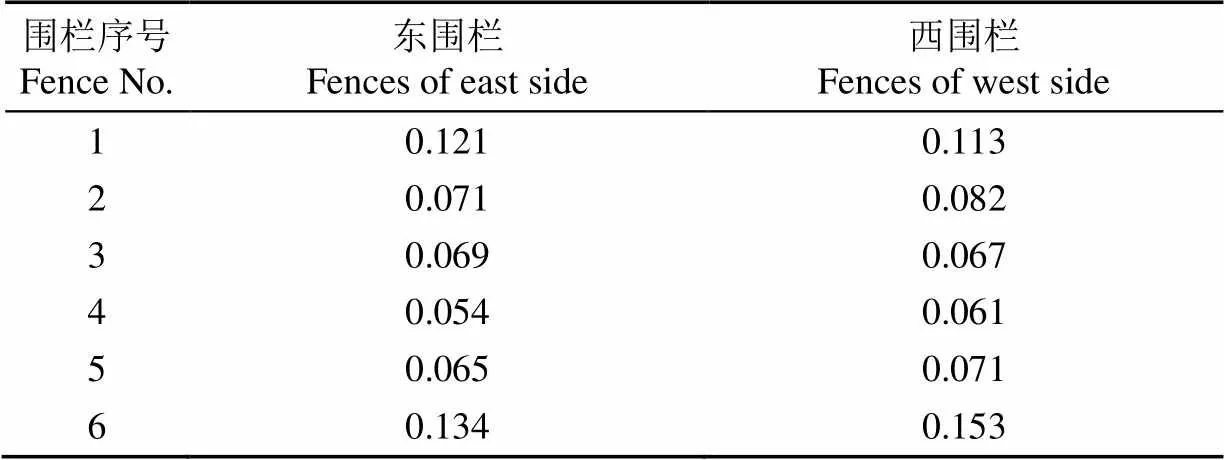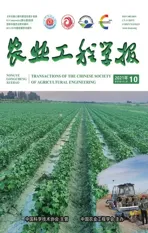冬季采暖保育猪舍送排风管道组合换气系统设计与评价
2021-09-02吴志东房俊龙巴文革李海涛蔡有杰程渠林
吴志东,房俊龙,巴文革,吴 爽,李海涛,蔡有杰,程渠林
冬季采暖保育猪舍送排风管道组合换气系统设计与评价
吴志东1,2,3,房俊龙1※,巴文革1,吴 爽1,李海涛4,蔡有杰2,程渠林2
(1. 东北农业大学电气与信息学院,哈尔滨 150030;2. 齐齐哈尔大学机电工程学院,齐齐哈尔 161006;3. 黑龙江省智能制造装备产业化协同创新中心,齐齐哈尔 161006;4. 黑龙江省农业机械工程科学研究院齐齐哈尔农业机械化研究所,齐齐哈尔 161006)
为实现保育猪舍内局部环境通风调控,该研究设计一种垂直送排风管道组合换气系统。采用CFD(Computational Fluid Dynamics)技术对垂直管道通风模式下舍内的空气流场进行模拟,并以相对湿度和CO2浓度作为输入变量建立通风模糊控制系统。模拟结果显示保育猪所在水泥地板区域风速保持在0.1~0.2 m/s。参照模拟结果,以猪栏为通风单元对保育猪舍通风系统进行改造,舍内气流不均匀性系数在0.1以下,表明采用该换气系统的保育猪舍通风均匀性较好;猪舍温度在21~25 ℃,相对湿度小于70%,NH3浓度小于5 mg/m3,CO2浓度小于1 200 mg/m3,舍内各项环境参数适宜保育猪健康生长。系统运行功耗为270~1 150 W。现场测试与分析结果表明,该垂直送排风管道组合换气系统,可以精确控制猪舍环境,兼顾冬季猪舍通风与保温问题。
温度;湿度;环境调控;保育猪舍;管道通风;CFD;模糊控制;性能评价
0 引 言
通风换气是维持猪舍内环境质量的技术手段。目前,横向或纵向通风模式即猪舍两侧横向或者纵向墙上安装风机进行机械通风的模式,在猪舍通风中应用较为广泛,但在北方寒冷冬季,上述2种通风模式均无法实现密闭猪舍局部环境调控,以及解决猪舍通风不均匀问题[1]。相比横向或纵向通风模式,采用管道均匀开口送风,其结构简单,同时能增大通风面积和空气的均匀性,可避免贼风或通风死角的出现[2-3]。
CFD技术常用于模拟畜舍在机械通风条件下室内温度和气流的分布规律[4-5]。Hoff等[6]较早利用湍流模型模拟了猪舍内气流和温度场的分布。Bjerg等[7]利用CFD技术对猪舍结构改变后的舍内气流分布进行研究,通过模拟和现场监测数据分析,发现结构的改变对舍内气体分布影响较大。贺城等[8]采用CFD技术对猪舍气流场和温度场进行模拟和研究,气流运动组织可以清晰呈现,为猪舍环境调控提供数据支撑。Mossad等[9]利用CFD技术模拟猪舍内空气流场和温度场,从而优化设计猪舍通风结构。以负压通风和水泡粪的保育猪舍为研究对象,应用CFD技术对舍内空气流场进行模拟,可以通过模拟结果掌握保育猪和工作人员呼吸带所在高度的风速、温度和相对湿度等数据,为通风结构优化提供基础数据[10]。Seo等[11]对猪舍模型进行简化,有效模拟了猪舍内的气流和温度,并分析送风口面积对气流场均匀性影响较大。以上的研究多是以横向或纵向模式为基础进行优化,未能对通风结构进行创新与改造,所以,并未有效解决通风不均匀性问题。合理的垂直通风模式可以更好的保证通风的均匀性和稳定性,换气效率高,便于猪舍小环境精确控制[12-13]。保育猪对生长环境的要求更为严格,所以,针对保育猪舍通风模式进行深入研究更具有代表性。借鉴以上研究方法,采用CFD技术对送排风管道组合通风换气模式下保育猪舍内空气流场进行模拟,并对模拟结果分析,验证该通风模式的可行性,为现场改造提供参考数据。
猪只不同生长阶段对环境的要求也不相同,而保育阶段猪只生长较快,生长环境需要实时调控。模糊控制则作为智能调控方法,广泛应用在猪舍环境调控系统中,为自动化、智能化养殖提供技术保障[14-15]。基于模糊控制理论建立猪舍多环境因子调控系统,能够根据温度、相对湿度以及各气体浓度的变化对猪舍环境进行实时调控[16]。李立峰等[17]在Kingview开发平台上,综合考虑分娩母猪舍温、湿度和NH3浓度对环境的影响,采用模糊控制技术和解耦控制技术,可以同时对通风和水暖系统进行调控。谢秋菊等[18]针对不同季节提出模糊控制策略,以温度、相对湿度、NH3等参数为输入变量,建立和优化猪舍通风调控系统,现场数据分析证明基于多环境因子的调控策略能够较好的满足猪舍环境控制需求。Ma等[19]综合猪舍环境参数、生猪生长信息和系统控制设备的状态,利用遗传算法确定猪舍环境调控最优解,可以有效地对调控策略进行优化,但算法较为复杂,对调控系统硬件要求较高。
该设计为实现寒区冬季保育猪舍环境精确调控,研究针对保育猪舍的送排风垂直管道换气系统,并选用对猪舍实际环境调控起决定性的因素作为控制变量,探究易于满足局部小环境实时调控需求的方法,对寒地保育猪健康养殖具有重要意义。
1 材料与方法
1.1 试验猪舍
试验猪舍位于黑龙江省齐齐哈尔市建华区,占地面积约为15 000 m2,年出栏量可达5 000头,具有6个保育猪舍,每间猪舍共12个围栏,每栏面积约8.75 m2,养殖10~12头保育猪,围栏地面由漏粪地板和水泥地板暖炕组成,漏粪地板缝隙宽度为15 mm,距舍内水泥地面高度为0.5 m,中间过道下方为粪槽,舍内地面距棚顶3 m,取暖方式以水泥地板暖炕为主,灯暖为辅。如图1所示,单间保育猪舍面积为170 m2,南侧墙体设置4个窗户,并配有2台定速风机,功率均为370 W,1台变速风机,功率为320 W;北侧墙体设置1个门,2个窗户,冬季开门和窗进行通风。
1.2 试验猪舍数据监测及分析
2019年12月至2020年1月,对未改造前保育猪舍环境监测,利用泵吸式气体检测仪(型号:HD5S+,分辨率:0.1 mg/m3,误差:±3% F.S)对舍内气体检测,发现湿度和CO2浓度严重超标,存在少量NH3,无其他气体。原因分析:粪便由漏粪地板通过粪槽排到舍外,清粪较为及时,所以产生NH3与H2S等有害气体较少;但为使舍内保温,通风较少,CO2和湿气无法排除。多点布置传感器,采用温湿度传感器模块(型号:SHT30,温度分辨率:0.01 ℃,误差:±0.2 ℃;湿度分辨率:0.01% RH,误差:±0.2 ℃),监测温度、湿度、NH3和CO2浓度,图1中A、B、C、D、E、F为传感器节点所在位置,高度为渗漏地板上方0.2 m(保育猪呼吸高度)处,其中,2020年1月5日部分监测数据如图2所示。
通过图2各曲线变化可知,近窗一侧各项数值相对较低,猪舍中间区域围栏相对其他位置围栏各项数值较大;午间光照较强即温度较高时间段内,CO2和NH3浓度明显提升。比对国家标准[20],温度始终处于适宜范围内,NH3浓度符合标准要求,但相对湿度和CO2浓度超标。以CO2浓度和空气湿度作为环境调控输入变量,提高换气次数,可以更有效调节猪舍内环境。
2 猪舍空气流场数值模拟及模糊控制系统
2.1 舍内空气流场数值模拟
猪舍等比例建模如图3所示,未通风状态下,猪舍视为密闭环境,为了简化模型,忽略食槽、通风管道和风机等对舍内气流的影响,网格划分数量为645 436个。各围栏水泥地板正上方为送风口,距离水泥地板0.9 m,中间过道处为排风口,距离地面0.4 m,水泥地板表面温度为33 ℃。送风管道直径为0.3 m,送风口设置为速度入口,速度为0.5 m/s;排风管道直径为0.3 m,排风口设置为速度出口,速度为1 m/s[21]。
利用Fluent软件数值求解,选用收敛性较好、误差较小的标准湍流模型,舍内气流场流线如图4所示。
图4中送风口和排风口处均呈现绿色,对照图中左侧比色柱,表明此处风速最大,且最大风速可达0.9 m/s。图4a中,除送风口和排风口处,其他区域风速在0.1~0.2 m/s范围内,且气流场流线密度较为均匀,表明垂直平面通风较为均匀;同时,中间过道即粪槽处气流线密集,且风速较大,有利于粪便带来的污浊气体和湿气快速排出。图4b中,单围栏内送风口和排风口之间气流场流线形成循环,且围栏交界处气流场流线稀疏,表明单围栏实现局部通风;同时,单围栏内气流场流线密度较为均匀,表明各围栏水平平面通风均匀。气流模拟结果说明以围栏为单元进行送排风垂直管道的组合通风模式,通风气流均匀,局部小环境可以实现循环通风,通风路径短,可以提高换气效率,避免污浊气体交叉流动。
2.2 控制系统硬件组成
如图5所示,控制系统硬件采用模块化设计,由传感器节点和控制终端组成,便于维护。考虑到相邻围栏之间空气流动的影响,同时为降低成本,分别在东2和5号围栏,西2和5号围栏配置传感器节点,共计配置4传感器节点,每个节点同时控制3个围栏通风单元启停。各节点由传感器集成模块(包括:温度、相对湿度、NH3以及CO2浓度检测功能)和驱动模块组成。传感器节点与控制终端采用串口通信,实现各围栏局部通风与进排风口处主风机联动。控制终端采用STM32微控制器,同时配置液晶显示、按键以及驱动模块,控制各主风机。
2.3 通风模糊控制
针对保育猪舍环境受多变量因素影响、实时变化和非线性的特点,控制系统采用模糊控制方法。根据采集数据分析,试验猪舍主要超标因素为相对湿度和CO2浓度,选取相对湿度监测值与预设值之差Δ,以及CO2浓度监测值与预设值之差Δ作为模糊输入变量,以风机启停模式作为输出量,模糊控制模型如图6所示。
根据规模猪场环境参数及环境管理国家标准,相对湿度保持在60%~70%,CO2浓度不能大于1 200 mg/m3为适宜范围。本文以65%为最适宜湿度的预设值,基本论域为[-6%, 6%],语言论域∈[-3, 3];以600 mg/m3为CO2浓度预设值,基本论域为[-600, 600],语言论域[-300, 300],为方便系统集成,此论域倍数减小100,相对湿度语言论域保持一致。模糊集合为[负大,负中,负小,零,正小,中,正大],即[NB, NM, NS, ZO, PS, PM, PB],输入变量量化因子K=0.5,K=0.5。
为降低能耗,实现变速、变量通风调控,根据各围栏通风风机启动数量,对舍外送风口和排风口风机进行变速调控,包括停机(0)、低速(0<≤2)、中速(2<≤4)、高速(4<≤6)4种模式,论域为[0, 3],模糊集合为[停机, 低速, 中速, 高速],即[ST, LS, MS, HS],输出量化因子K=1。输入变量和输出量隶属函数如图7所示。
利用MATLAB simulink建立如图8所示通风模糊控制系统模型,其中,Fuzzy Logic Controller为双变量输入模糊逻辑控制器,通风启停模式即调速等级作为输出量,通过示波器Scop监视调控模式输出曲线,如图9所示。
图9中,0、1、2、3分别代表停机、低速、中速、高速四种主风机通风调速状态。6点前,未设置通风,处于停机状态,主要原因是舍外温度较低,加之保育猪活动量和排便量较少,猪舍环境一般符合要求;早晨8点时,因舍内一夜未通风,加之保育猪开始活动和排便,舍内湿度和CO2浓度升高,中速通风;上午10时开始,舍内外温度均升高,同时保育猪活动和排便量增多,舍内相对湿度和个气体浓度增大,系统进行高速通风。控制系统根据舍内环境变化,实现逐级切换,满足变量、变速调控需求。
4 系统性能测试与评价
4.1 管道通风改造
图10为通风系统改造试验保育猪舍,新鲜空气由舍外送风口主风机进入送风管道;舍内污浊空气由舍外排风口主风机排出。舍内对应每个围栏,分别设置1个舍内送风口和1个舍内排风口,共计12组,舍内送风口安装管道风机,功率为35 W,最大风量为220 m3/h。舍外送风口主风机共2个,独立启动,均选用变速管道轴流风机,功率均为185 W,最大风量为1 600 m3/h。舍外排风口主风机1个,选用变速管道轴流风机,功率为360 W,最大风量为3 200 m3/h。舍内送风口加装风帽,便于调节通风角度。
4.2 气流均匀性
根据文献[22],并参照民用建筑气流分布性能评价标准[23],利用气流不均匀性系数J作为保育舍内通风气流均匀性评价指标,J越小表明舍内通风均匀性越好。
式中J表示舍内高度为平面的气流均匀性系数,无量纲;v表示高度为平面的平均气流速度,m/s;v表示第个监测点气流速度,m/s;表示监测点数量。

1.主风机(舍外送风口) 2.送风管道 3.管道风机 4.舍内送风口 5.主风机(舍外排风口) 6.排风管道 7.舍内排风口
通风系统启动,取0.4 m高度即保育猪高度为监测点高度,利用热敏式风量计(型号:GM8911,解析度:0.01,误差:±3%)监测,每个猪栏均匀分散监测10个点气流速度,表1为计算后各猪栏J数值。

表1 各猪栏不均匀性系数
根据表1数据可知,6号围栏不均匀系数较高,其原因是距离窗户较近,舍外冷风通过缝隙进入,通过密封可以有效缩小不均系数,避免贼风;其次,1号围栏系数较高,其原因是距离连廊门和窗户较近,连廊内冷风通过缝隙进入舍内,通过猪栏一侧固定隔风板可以缩小不均匀系数。通过进一步改造,舍内气流不均匀系数可保持0.1以下,表明送排风管道组合换气通风模式下的保育猪通风均匀性较好。
4.3 温度分布
猪舍改造后,每栏投放10~12只保育猪进行养殖。通风会影响猪舍内温度,利用红外线热成像仪(型号:Fluke TiS60+,分辨率:320 x 240像素,热灵敏度:≤ 0.045 ℃)对舍内各围栏温度进行实测。食料槽长时间放置于猪栏内,其温度可以视为保育猪所在区域温度,取保育猪高度0.4 m处食料槽为参考面,图11为部分围栏温度实测图像。
通过图11可知,以食槽为参考面,西围栏1环境温度为24.1 ℃,东围栏6环境温度为22.9 ℃,高温显示为保育猪体温。猪舍其他围栏环境实测温度均保持在21~25 ℃之间,表明送排风管道组合通风换气状态下,保育猪舍环境实测温度均在保育猪健康生长需求范围内。
4.4 其他数据监测
通过多点布置传感器集成模块实时监测NH3、CO2、温度和湿度,并利用泵吸式气体检测仪随机检测舍内各区域环境数据,各项参数均在保育猪适宜生长范围内,相对湿度小于70%,NH3浓度小于5 mg/m3,CO2浓度小于1 200 mg/m3。
4.5 系统功耗
换气系统运行总功率总包括由各风机运行总功率,总表示为
总=管道风机+送+排(3)
式中管道风机为各围栏送风口管道风机运行时所用总功率,W;送为舍外送风口主风机运行所用总功率,W;排为舍外排风口主风机运行所用功率,W。
总最大值为1 150 W,即为所有风机都运行时,其功率大于未改造前通风系统运行总功率1 060 W,但送排风管道组合换气系统是以各围栏为单位进行通风,同时舍外送风口和排风口的主风机可变速控制,通风系统运行功耗并非固定不变。单传感器节点控制通风即为功耗最小时,约为270 W,所以系统功耗范围为270~1 150 W。变量、变速的通风模式可有效降低系统功耗;同时,以试验猪舍12个围栏为例计算通风热损耗,则最小通风热损耗即单围栏局部通风时产生的热损耗,为改造前整体猪舍通风热损耗的1/12。
5 结 论
1)利用CFD技术对保育猪舍送排风垂直管道组合换气状态下的保育猪舍空气流场进行模拟,气流场流线和空气流场分布均匀,风速保持在0.1~0.2 m/s,适宜保育猪生长。
2)通过猪舍现场改造与实测,温度、湿度、CO2和NH3浓度均在保育猪适宜生长范围内;对舍内气流均匀性计算与分析,气流不均匀性均可保持在0.1以下。
3)采用模糊控制方法,双变量输入控制,四种通风模式可以逐级切换;同时,保育猪围栏为通风单元进行局部通风调控,保证猪舍实现局部环境精细调控,系统运行功耗控制在270~1 150 W,最小通风热损耗为改造前整体猪舍通风热损耗的1/12。
[1] 王德福,黄会男,张洪建,等. 生猪养殖设施工程技术研究现状与发展分析[J]. 农业机械学报,2018,49(11):1-14.
Wang Defu, Huang Huinan, Zhang Hongjian, et al. Analysis of research status and development on engineering technology of swine farming facilities[J]. Transactions of the Chinese Society of Agricultural Machinery, 2018, 49(11): 1-14. (in Chinese with English abstract)
[2] Caputo Antonio C, Pelagagge Pacifico M. Upgrading mixed ventilation systems in industrial conditioning[J]. Applied Thermal Engineering, 2010, 29(14): 3204-3211.
[3] Nielsen P V, Topp C, Sonnichsen M, et al. Air distribution in rooms generated by a textile terminal-comparison with mixing and displacement ventilation[J]. ASHRAE Transactions, 2005, 111(1): 733-739.
[4] Rojano F, Bournet P E, Hassouna M, et al. Modelling heat and mass transfer of a broiler house using computational fluid dynamic[J]. Biosystems Engineering, 2015, 136(7): 51-68.
[5] Gebremedhin K G, Wu B. Simulation of flow field of a ventilated and occupied animal space with different inlet and outlet conditions[J]. Journal of Thermal Biology, 2005, 30(5): 343-353.
[6] Hoff S J, Janni K A, Jacobson L D. Three-dimensional buoyant turbulent flows in a scaled model, slot-ventilated, livestock confinement facility[J]. Transactions of the ASAE, 1992, 35(2): 671-686.
[7] Bjerg B, Svidt K, Zhang G, et al. SE-Structures and Environment: The effects of pen partitions and thermal pig simulators on airflow in a livestock test room[J]. Journal of Agricultural Engineering Research, 2000, 77(3): 317-326.
[8] 贺城,牛智有,齐德生. 猪舍温度场和气流场的CFD 模拟比较分析[J]. 湖北农业科学,2010,49(1):134-136.
He Cheng, Niu Zhiyou, Qi Desheng. CFD simulation and comparative analysis about air temperature and airflow in the piggery[J]. HuBei Agricultural Science, 2010, 49(1): 134-136. (in Chinese with English abstract)
[9] Mossad R R. Numerical predictions of air temperature and velocity distribution to assist in the design of natural ventilation piggery buildings[J]. Australian Journal of Multi-Disciplinary Engineering, 2011, 8(2): 181-187.
[10] 汪开英,李开泰,李王林娟,等. 保育舍冬季湿热环境与颗粒物CFD模拟研究[J]. 农业机械学报,2017,48(9):270-278.
Wang Kaiying, Li Kaitai, Liwang Linjuan, et al. CFD simulation of indoor hygrothermal environment and particle matter of weaned pig building[J]. Transactions of the Chinese Society for Agricultural Machinery, 2017, 48(9): 270-278. (in Chinese with English abstract)
[11] Seo I H, Lee I B, Moon O K, et al. Modelling of internal environmental conditions in a full-scale commercial pig house containing animals[J]. Biosystems Engineering, 2012, 111(1): 91-106.
[12] Zong C, Feng Y, Zhang G Q, et al. Effects of different air inlets on indoor air quality and ammonia emission from two experimental fattening pig rooms with partial pit ventilation system--Summer condition[J]. Biosystems Engineering, 2014, 122(3): 163-173.
[13] 吴中红,陈泽鹏,臧建军,等. 湿帘冷风机-纤维风管通风系统对妊娠猪猪舍的降温效果[J]. 农业工程学报,2018,34(18):268-276.
Wu Zhonghong, Cheng Zepeng, Zang Jianjun, et al. Cooling performance of wet curtain fan-fabric duct ventilation system in house of pregnant sows[J]. Transactions of the Chinese Society of Agricultural Engineering (Transactions of the CSAE), 2018, 34(18): 268-276. (in Chinese with English abstract)
[14] 冯江,林升峰,王鹏宇,等. 基于自适应模糊PID控制的猪舍温湿度控制系统研究[J]. 东北农业大学学报,2018,49(2):73-86.
Feng Jiang, Lin Shengfeng, Wang Pengyu, et al. Piggery temperature and humidity control system based on adaptive fuzzy PID control[J]. Journal of Northeast Agricultural University, 2018, 49(2): 73-86. (in Chinese with English abstract)
[15] 黄俊仕,熊爱华,董钊,等. 生猪养殖环境智能监控系统设计[J]. 黑龙江畜牧兽医,2021(1):12-18,23.
Huang Junshi, Xiong Aihua, Dong Zhao, et al. Design of intelligent monitoring system for the environment of pig farming[J]. Heilongjiang Animal Science and Veterinary Medicine, 2021(1): 12-18, 23. (in Chinese with English abstract)
[16] 谢秋菊. 基于模糊理论的猪舍环境适应性评价及调控模型研究[D]. 哈尔滨:东北农业大学,2015.
Xie Qiuju. Environmental Suitability Assessment and Control Model Development for a Swine House Based on Fuzzy Theory[D]. Harbin: Northeast Agricultural University, 2015. (in Chinese with English abstract)
[17] 李立峰,武佩,麻硕士,等. 基于组态软件和模糊控制的分娩母猪舍环境监控系统[J]. 农业工程学报,2011,27(6):231-236.
Li Lifeng, Wu Pei, Ma Shuoshi, et al. Monitoring and controlling system for delivery sow house environment based on configuration software and fuzzy control[J]. Transactions of the Chinese Society of Agricultural Engineering (Transactions of the CSAE), 2011, 27(6): 231-236. (in Chinese with English abstract)
[18] 谢秋菊,苏中滨,Ni Jiqin,等. 密闭式猪舍多环境因子调控系统设计及调控策略[J]. 农业工程学报,2017,33(6):163-170.
Xie Qiuju, Su Zhongbin, Ni Jiqin, et al. Control system design and control strategy of multiple environmental factors in confined swine building[J]. Transactions of the Chinese Society of Agricultural Engineering (Transactions of the CSAE), 2017, 33(6): 163-170. (in Chinese with English abstract)
[19] Ma C, D Zhao, Wei N, et al. Intelligent controlling system of pig growth environment[C]// Intelligent Computation Technology and Automation (ICICTA), 2010 International Conference on. IEEE, 2010.
[20] 中华人民共和国农业部. GB-T 17824. 3-2008 规模猪场环境参数及环境管理[S]. 北京: 中国标准出版社, 2008.
[21] 高云,陈震撼,王瑜,等. 多环境参数控制的猪养殖箱设计及箱内气流场分析[J]. 农业工程学报,2019,35(2):203-212.
Gao Yun, Chen Zhenhan, Wang Yu, et al. Design for pig breeding chamber under multiple environment variable control and analysis of internal flow field[J]. Transactions of the Chinese Society of Agricultural Engineering (Transactions of the CSAE), 2019, 35(2): 203-212. (in Chinese with English abstract)
[22] 邓书辉,施正香,李保明,等. 低屋面横向通风牛舍空气流场CFD模拟[J]. 农业工程学报,2014,30(6):139-146.
Deng Shuhui, Shi Zhengxiang, Li Baoming, et al. CFD simulation of airflow distribution in low profile cross ventilated dairy cattle barn[J]. Transactions of the Chinese Society of Agricultural Engineering (Transactions of the CSAE), 2014, 30(6): 139-146. (in Chinese with English abstract)
[23] 赵荣义,范存养,薛殿华,等. 空气调节[M]. 第4版. 北京:中国建筑工业出版社,2009.
Design and evaluation of combined ventilation system with air supply and exhaust ducts for a nursery heating piggery in winter
Wu Zhidong1,2,3, Fang Junlong1※, Ba Wenge1, Wu Shuang1, Li Haitao4, Cai Youjie2, Cheng Qulin2
(1.,,150030,; 2.,,161006,; 3.,161006,; 4.,161006,)
Current ventilation mode needs to be updated in a nursery piggery, due mainly to the uneven distribution of airflow derived from the great contradiction between ventilation and heat preservation under the relatively low temperature of the cold region in winter. The previous investigation on data collection found that the relative humidity and the concentration of CO2generally exceeded the standard value in a nursery piggery. Therefore, the main challenge was how to efficiently supply fresh air. In this study, computational fluid dynamics (CFD) was used to simulate the airflow field in the nursery piggery under the combined ventilation system of air supply and exhaust ducts. The diameter of the duct was 0.3 m. The wind speeds of air supply and exhaust were set at 0.5 m/s and 1 m/s, respectively. The results revealed that the circulation ventilation was formed between the air supply inlet and exhaust outlet. The wind speed was maintained between 0.1 m/s and 0.2 m/s in the cement floor area where the piglets live. An even distribution of air flow was achieved to shorten the ventilation path for the diffusion of dirty gas, while improving the ventilation efficiency. A facile control system was specifically designed to consist of each control node in a modular approach. LoRa wireless communication was used to transmit data between control nodes. At the same time, fuzzy control was applied in the control system. Relative humidity and CO2concentration were used as input variables, whereas, the speed control mode of main fans was used as an output variable. The quantization factors of input variablesKandKwere both 0.5, while, the quantization factor of output was 1. A general platform of MATLAB Simulink was selected to establish the model of the fuzzy control system. The simulation results showed that the proposed system responded quickly, while switched step by step in the four types of ventilation modes, including downtime, low, medium and high speed. A fence was applied as the ventilation unit to transform the fresh air, considering the air flow field after simulation. A field experiment was also carried out in a large-scale pig farm in Jianhua District, Qiqihar City, Heilongjiang Province of China in December 2019. It was found that the uneven coefficient of airflow was below 0.1 in the cement floor area of piglets, indicating a better uniformity of ventilation in the nursery piggery under the combined ventilation system of air supply and exhaust ducts. An infrared thermal imager and a gas detector were used to detect the environmental data of each area in the piggery. The measuring data showed that the temperature was kept between 21 ℃ and 25 ℃, the relative humidity was less than 70%, the concentration of NH3was less than 5 mg/m3, the concentration of CO2was less than 1 200 mg/m3, indicating the overall environment without other gases was suitable for the living of piglets. The combined ventilation system of air supply and exhaust ducts can be expected to realize the on-demand ventilation. Furthermore, the power consumption of the system was relatively low, ranging from 270 to 1 550 W. Consequently, the developed ventilation system can accurately control the piggery environment and efficiently alleviate the various changes between ventilation and heat preservation in winter.
temperature; humidity; environmental regulation; nursery piggery; duct ventilation; CFD; fuzzy control; performance evaluation
10.11975/j.issn.1002-6819.2021.10.018
S817.3
A
1002-6819(2021)-10-0152-07
吴志东,房俊龙,巴文革,等. 冬季采暖保育猪舍送排风管道组合换气系统设计与评价[J]. 农业工程学报,2021,37(10):152-158.doi:10.11975/j.issn.1002-6819.2021.10.018 http://www.tcsae.org
Wu Zhidong, Fang Junlong, Ba Wenge, et al. Design and evaluation of combined ventilation system with air supply and exhaust ducts for a nursery heating piggery in winter[J]. Transactions of the Chinese Society of Agricultural Engineering (Transactions of the CSAE), 2021, 37(10): 152-158. (in Chinese with English abstract) doi:10.11975/j.issn.1002-6819.2021.10.018 http://www.tcsae.org
2021-02-03
2021-05-13
黑龙江省教育厅省属高等学校基本科研业务费科研项目(135509411,135409102);黑龙江省教育科学“十三五”规划2020年度重点课题(GJB1320388);齐齐哈尔大学教育科学研究项目(GJZRYB202006)
吴志东,讲师,博士,研究方向为农业环境控制和自动化设备。Email:wzd139446@163.com
房俊龙,教授,博士,研究方向为农业自动化。Email:jlfang@neau.edu.cn
